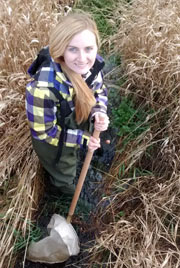Coming home to NCC
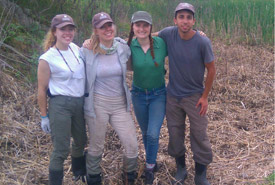
Teamwork makes the dream work (Photo by NCC)
I don’t claim to be an expert on every inch of Ontario's Frontenac Arch. One summer as a conservation technician with the Nature Conservancy of Canada (NCC) is nowhere near enough time to explore everything, but in 2016, the wetlands, rock barrens and forests of NCC’s eastern region quickly became some of my favourite natural areas in the province.
I truly believe the skills I learned working with NCC prepared me for almost anything a profession in the environmental world can throw at me. Even though it was only a year ago that I had my last canoe ride at Elbow Lake on the Frontenac Arch, I now manage a Canada-wide urban forestry program — and a lot of paperwork.
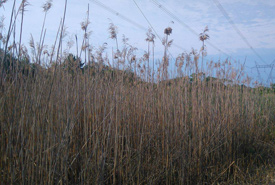
Phragmities patch before it was cut down at Loughborough Wilderness Complex (Photo by Megan Quinn)
It’s been a difficult transition from sitting on a dock to sitting at a desk, so when I saw on NCC’s website that they had a Conservation Volunteers (CV) opportunity at Loughborough Wilderness Complex, also in the Frontenac Arch, I jumped at the chance to get my feet wet again — literally! It was even more special when I realized the phragmites patch, also known as common reed, that we were removing was one I had mapped as a technician the year before.
I filled out my information online, clicked send, and then I panicked.
My first thoughts:
What if I don’t remember how to pack for a day in the field?
Don’t worry, NCC sends out a handy list to anyone who signs up for a CV event. It details where you need to go, what you need to bring and what you should expect at the event.
What if I’ve forgotten what phragmites looks like?
Megan, it’s about eight-feet high and grows in dense patches — it’s pretty hard to miss.
Am I physically up for a day in the field?
There are activities for everyone to get involved in at CV events, no matter what your level of fitness and experience is.
Driving toward the site at the Loborough Wilderness Complex, I was hit with a sense of nostalgia. It would be a wonderful reunion with my good friend and fieldwork partner, Kristen Glass, conservation technician for NCC’s Ontario Region.
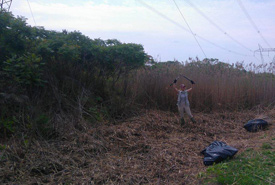
During phragmites removal, Kristen Glass shows she won't be defeated! (Photo by Megan Quinn)
With the help of old friends and new, we successfully tackled the phragmites patch and made a difference to an area of the Frontenac Arch.
There is something inspiring about spending the day interacting with nature, and there are so many lessons to be learned from field work:
Creative thinking is the best skill you can have
Whether you have a mountain of paperwork or a phragmites jungle to get through, creative thinking is the way forward. For example, we worked out that if we gave the phragmites stems a big, old hug by holding them in a bundle, they were much easier to cut down.
A good lunch makes anything seem possible
Whether it’s enjoying a sandwich by a wetland, or having a snack before a big budget meeting, the right food can make any daunting task seem doable.
Teamwork makes the dream work!
Sometimes it’s hard not to feel isolated in an office setting, but reaching out to your coworkers makes everything run so much more smoothly. In the same way, six people tackling a stand of phragmites is much more successful than just one.
Join the Conservation Volunteers team!
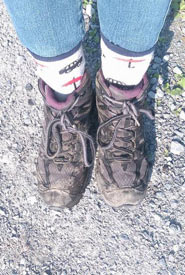
During field work, always remember to put your socks outside of your pants. (Photo by Megan Quinn)
Whether you’re a student trying to break into the industry, a seasoned veteran who misses being outside or someone who just wants to spend more time in nature, volunteering with NCC (or joining the team as a conservation technician) is the perfect way to give back to the environment and your community, not to mention beneficial to your own mental well-being.
Coming back to volunteer with NCC truly felt like coming home. Nowadays I spend more time in dresses than khakis, but there’s nothing that compares to hands-on field work. Although, as any of my co-workers will tell you, I still sometimes absentmindedly tuck my trousers into my socks!
You can take the girl out of the field, but you can’t take the field out of the girl.

